Wheeler & Wilson's D9
- the long and short of it
by John Langdon
ISMACS News No. 106
March 2012
The D9 was launched in 1887 and was destined to become the company's most successful domestic. Driven by an efficient rotary hook, there is a tightness to the engineering that makes for very smooth operation - certainly compared to contemporary vibrating shuttle machines.

Captive Thread Post D9 in Drophead Treadle Table
By 1894, the W&W Nos. 5, 7, 8 and 10 were no longer made, so customers would have been offered the No.1 (curved needle) and the 'New No. 4' for shirt manufacture; No.6; No.11 to special order with the Number 10 buttonhole version. All basic work could be covered by the No.9 and versions of the No.12.
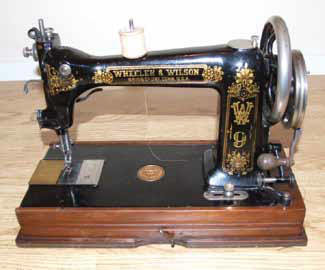
Single thread post D9-H-3
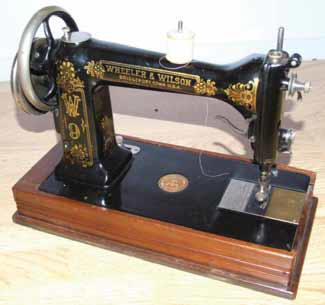
Single thread post D9-H-3
In its advertising, W&W claimed many things for the Number 9 that might not pass modern scrutiny, including - optimistically - a 300% greater efficiency.
Singer, at the time, was enjoying the success of its oscillating shuttle class 15 and wouldn't introduce their own rotary domestic, the class 115, until well into the 20th century.
The first No. 9s used the glass presser foot, seen on W&W machines since 1861, which had become popular with sewers who wanted to stitch very close to an edge.
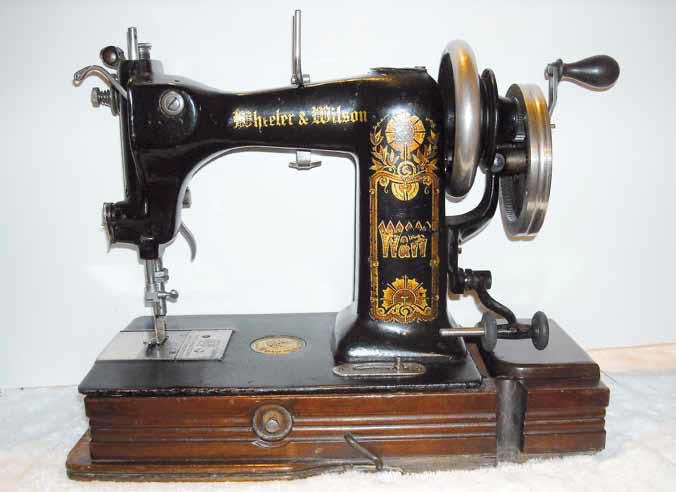
Short-base No. 9 with accessory compartment and folding thread post.
Despite this clear advantage, it was soon replaced with a pressed steel foot that attached from the rear; a design Singer imitated (and abandoned) on 66-1 to 66-3. Another feature, maintained on many W&W industrials subsequently, was the characteristic U-shaped, captive thread post.
Lee King's stand-mounted hand crank
An unusual feature of the thread path on the is the tiny pulley on the face plate that forms a secondary tension device; a feature that would reappear on cloned (and licensed) versions and become common on several of Singer's Bridgeport industrials (12W, etc.)
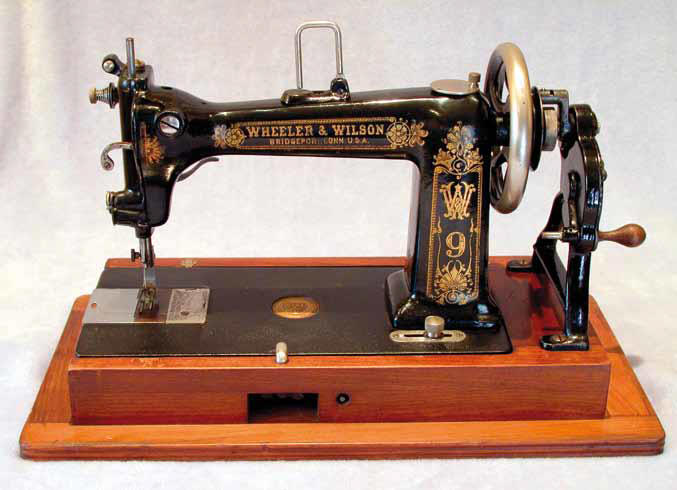
Lee King's stand-mounted hand crank
Unlike most of its contemporaries, only the D9's arm was decorated. The plain, black japanned bed - bearing only the bronze company medallion - gave it an understated elegance. W&W argued that decals on the bed got scratched quickly so refrained from putting them on horizontal surfaces.
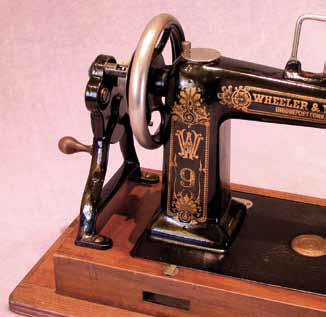
The above machine; rear view
Despite its success, the machine seemed to be in a constant state of change. The hinge and latch arrangement to hold the head to the base were revamped several times, the bobbin case holder was revamoped and one can see several changes to the decals. An interesting feature of the treadles was a brake to prevent back-pedalling.
Some early models had the hand-wheel separate, mounted on the wooden base, while later versions had the wheel assembly mounted on the machine pillar. Balance wheels, mysteriously, came in several different sizes.
Early portable bases were little more than a platform with wooden feet but soon gave way to a deeper receptacle. Some bases had a smooth, semicircular recess cut from the needle end of the woodwork which, with the slide plate removed, almost gave access to the bobbin. This cutaway was sometimes replaced with a movable flap. Sometimes with an accessory compartment provided under the balance wheel; sometimes not.
Wheeler & Wilson trade cards featuring the D9
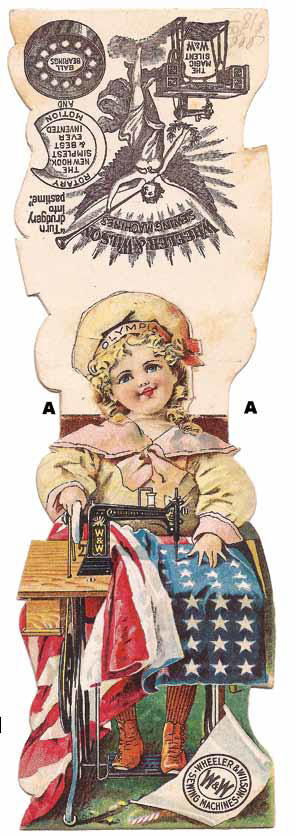
The die-cut card (above) folds along A–A, with the head cut out, to stand up.
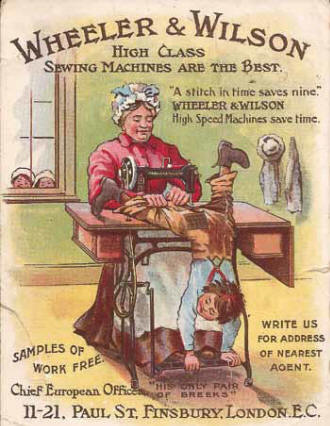
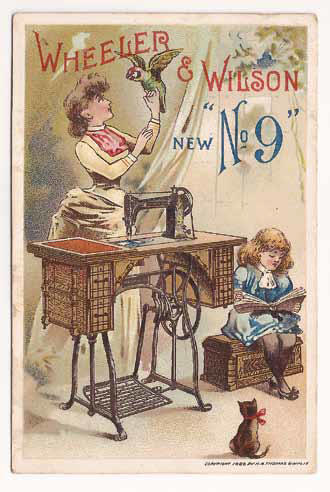
The "New No. 9" which became the D9(copyright date 1888).

Rose Sullivan's photos of her short base D9 with another version of the base.
Despite the provision of an accessory compartment, accessories for this model generally came in a carved, or plain, hardwood box yet there never seems to a place for storing it in the case.
The first portable covers were bentwood but eventually they became much more 'square', often with the case handle recessed into the top.
The Number 9 (later, D9) was regularly supplied as a portable (hand crank) with several treadle versions also available; in tables with 1, 3, 5 or 7 drawers and several enclosed 'parlour' cabinets. It threads from right to left and uses a 127x1 (9W1) needle.
The most conspicuous variation is the compact, short-bed D9 - exactly the same as the full-size version but only 10 1/2" long x 6" wide; a good 3" shorter. To keep the overall height of the short-base down, the thread post is mounted behind the arm, rather than on top. If the wooden base contains an accessory compartment, it measures 15"; though not all of them had this feature.
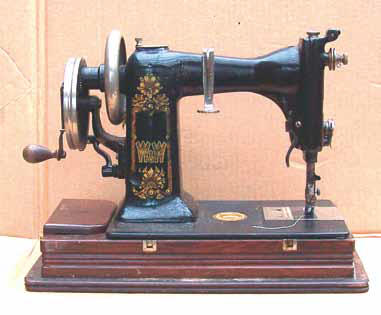
Rear, showing folding thread post.
David Best on his website (www.sewmuse. co.uk/) seems to show a further model that is only slightly shorter than the full-length D9, with a conspicuously slimmer slide cover plate.
In 1905, the Wheeler and Wilson Co. was taken over by Singer. The D9 was well-established in the market and its new parents weren't going to turn down sales, so production was switched to Elizabethport; probably because it was the only W&W domestic that they inherited and the New Jersey factory was the centre of Singer's domestic production. The company immediately rebranded the machine as the Singer 9W1.
For a couple of years it appeared in the Elizabethport catalogue, still in W&W livery as Singer used up old Bridgeport stock. A different bobbin was introduced and, by the 9W3, Singer had replaced the transfers with its own ornamentation set #19 (pearl) and eventually removed the W&W medallion from the bedplate.
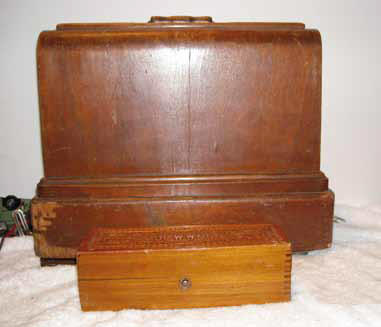
Short base case and separate carved top accessory box.
Several other changes introduced by Singer for models 9W7 to 9W13 required another bobbin change and totally new castings; including a longer bed and new spacing for the hinge pins to be accommodated in standard Singer cabinets. However, the slide cover plate still bore the W&W patent date of August 2nd 1892. By the end of production in 1913 (though some maintain the 1920s), Singer had scrapped the captive thread post in the centre of the arm, replacing it with a simple rod fixed to a re-designed, pear-shaped cover plate above the top of the pillar. A modified version of which would later re-appear on the 221.
With its square arm pillar and W&W styling, the 9W had never looked quite at home in Singer's catalogue and by the 1920s, once the Singer 101 rotary had established itself, the 9W7 was phased out. Though, inexplicably, I have a 9W manual dated as late as 1933. Not many class 9 machines seem to have survived which may be a clue to its popularity. (JL)





